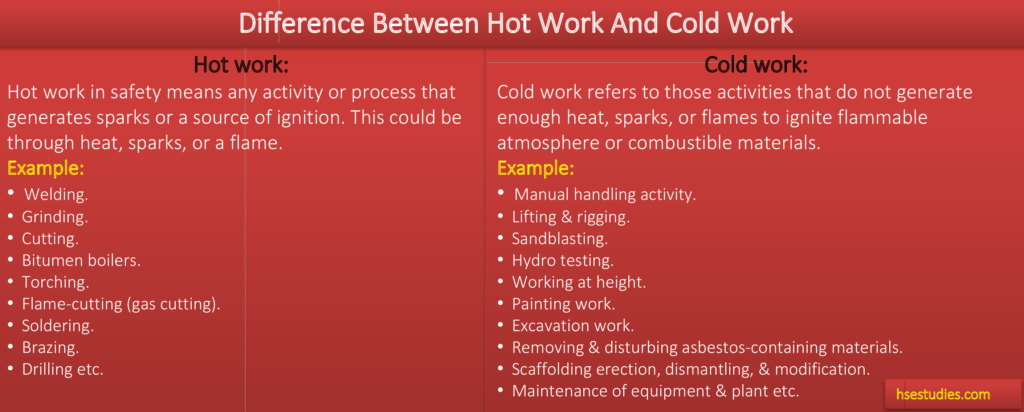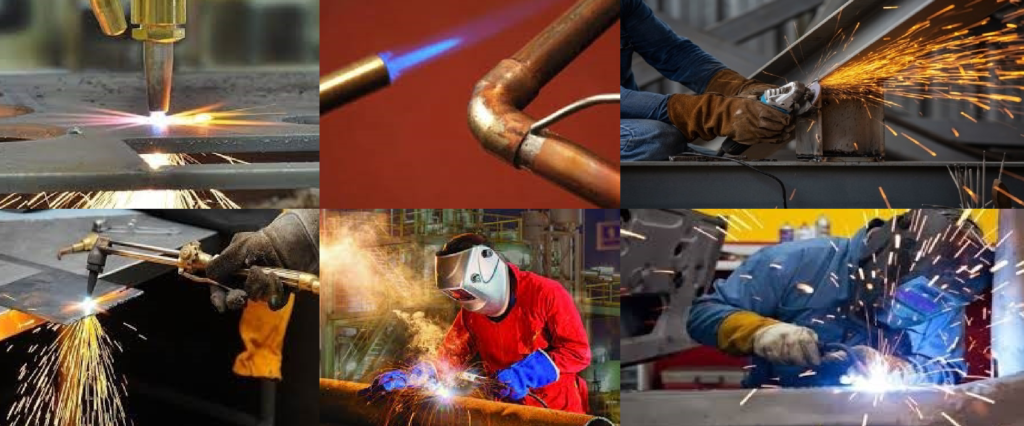The “Difference Between Hot Work And Cold Work” is that hot work generates sparks or open flames while cold work doesn’t. Hot work has the potential to cause fire & explosion, but Cold work doesn’t have the potential to do so.

What Is The Difference Between Hot Work And Cold Work?
The main “Difference Between Hot Work And Cold Work” is that hot work generates sparks or open flames while Cold work doesn’t. Hot work has the potential to cause fire & explosion, but Cold work doesn’t have the potential to do so. Before conducting these activities, a risk assessment must be carried out to identify the potential hazards & decide on control measures.
Both hot work and cold work are dangerous. Before commencing these activities, hazards associated with these tasks must be identified and controlled by implementing remedial safety control measures. Don’t think that hot work is dangerous and cold work is not. Both activities are dangerous if someone is doing these tasks in unsafe conditions without implementing proper safety measures.
What Is Hot Work In Safety?
Hot work in safety means any activity or process that generates sparks or a source of ignition. This could be through heat, sparks, or a flame. Hot work can be direct & indirect. In direct hot work, the equipment or tools generate a flame, while in indirect hot work, the work process generates heat, sparks, or a flame; for example, using an abrasive wheel to cut or grind the metal produces sparks.
Hot work can be dangerous if it’s not commenced with adequate safety control measures. It introduced new risks at your workplace that must be managed up to a safe level. Hot work may be either permanent or temporary. But, whenever, & wherever it takes place, it must be controlled by implementing adequate safety control measures.
All hazards involved in hot work (heat, sparks, open flames, hot surfaces, electricity, welding fumes, etc.) must be identified, and remedial control measures must be implemented to mitigate all potential hazards to work safely during hot work.

Hot Work Example
Hot work can be direct & indirect. In direct hot work, the equipment or tools generate a flame, while in indirect hot work, the work process generates heat, sparks, or a flame; for example, using an abrasive wheel to cut or grind the metal that produces sparks.
Hot work examples include:
- Welding.
- Grinding.
- Cutting.
- Bitumen boilers.
- Torching.
- Flame-cutting (gas cutting).
- Soldering.
- Brazing.
- Drilling etc.

Hot Work Hazards:
- Welding & grinding sparks
- compressed gas cylinders
- Explosive atmosphere
- Flying dust & debris
- Electricity
- Non-ionizing radiation
- Welding fumes
- Hot surface
- Molten metals
- Rotating wheels of angle grinders
Above are some common examples of hazards associated with hot work. The potential hazard during hot works must be identified & controlled by implementing adequate safety control measures before commencing hot work activities.
What Is Cold Work?
Cold work refers to those activities that do not generate enough heat, sparks, or flames to ignite flammable atmosphere or combustible materials. It can still involve hazards that must be evaluated during site inspection or risk assessment.
All hazards involved in cold work (working at height, suspended load, manual handling, poor housekeeping, deep excavation, sharp edge, pressurized pipelines, open hole, etc.) must be identified, and remedial control measures must be implemented to mitigate these all potential hazards to work safely during cold work.
Examples of cold work:
- Manual handling activity.
- Lifting & rigging.
- Sandblasting.
- Hydro testing.
- Working at height.
- Painting work.
- Excavation work.
- Working with asbestos-containing materials.
- Scaffolding erection, dismantling, & modification.
- Maintenance of equipment & plant etc.

Cold Work Hazards
- Working at height
- Manual handling
- Trailing cables and tools at the workplace
- Slippery work floor
- Sharp edge
- Suspended load
- Hazardous chemicals
- Excessive noise level
- Pressurized pipelines and vessels
- Confined space
- Deep excavation
- Poor illumination
- Poor ventilation
- Dust
- Poor weather conditions
Above are some common examples of hazards associated with cold work. The potential hazard during Cold work activity must be identified & controlled by implementing adequate safety control measures before commencing the Cold work activities.
Conclusion
The main “Difference Between Hot Work And Cold Work” is that hot work generates sparks or open flames while Cold work doesn’t. Hot work has the potential to cause fire & explosion, but Cold work doesn’t have the potential to do so. Never think that hot work is dangerous and cold is not. Both activities are hazardous & they must be carried out with adequate safety control measures.
The best way to work safely during hot & cold work is to identify the potential hazards and implement safety control measures before commencing these activities.
Q: What Is Hot Work In Safety?
Ans: Hot work in safety means any activity or process that generates sparks or a source of ignition. This could be through heat, sparks, or a flame.
Q: What Is Cold Work?
Ans: Cold work refers to those activities that do not generate enough heat, sparks, or flames to ignite flammable atmosphere or combustible materials. It can still involve hazards that must be evaluated during site inspection or risk assessment.
Q: Hot Work Example
Ans:
Welding.
Grinding.
Cutting.
Bitumen boilers.
Torching.
Flame-cutting (gas cutting).
Soldering.
Brazing.
Drilling etc.
Q: Cold Work Example
Ans:
Manual handling activity.
Lifting & rigging.
Sandblasting.
Hydro testing.
Working at height.
Painting work.
Excavation work.
Working with asbestos-containing materials.
Scaffolding erection, dismantling, & modification.
Maintenance of equipment & plant etc.
Q: What Is The Difference Between Hot Work And Cold Work?
Ans: The main “Difference Between Hot Work And Cold Work” is that hot work generates sparks or open flames while Cold work doesn’t. Hot work has the potential to cause fire & explosion, but Cold work doesn’t have the potential to do so.
- What Is Near Miss Definition In Safety? And 5 Safety Near Miss Examples
- 10 Crucial Work Permit Receiver Job Responsibilities & What Is Permit To Work In Safety?
- How Many Types Of Crane Are There? 6- Industrial Cranes Types.
- What Is The Tool Box Talk? Tool Box Talk Meaning & Topics
- 15 Common Safety Hazards In The Workplace
